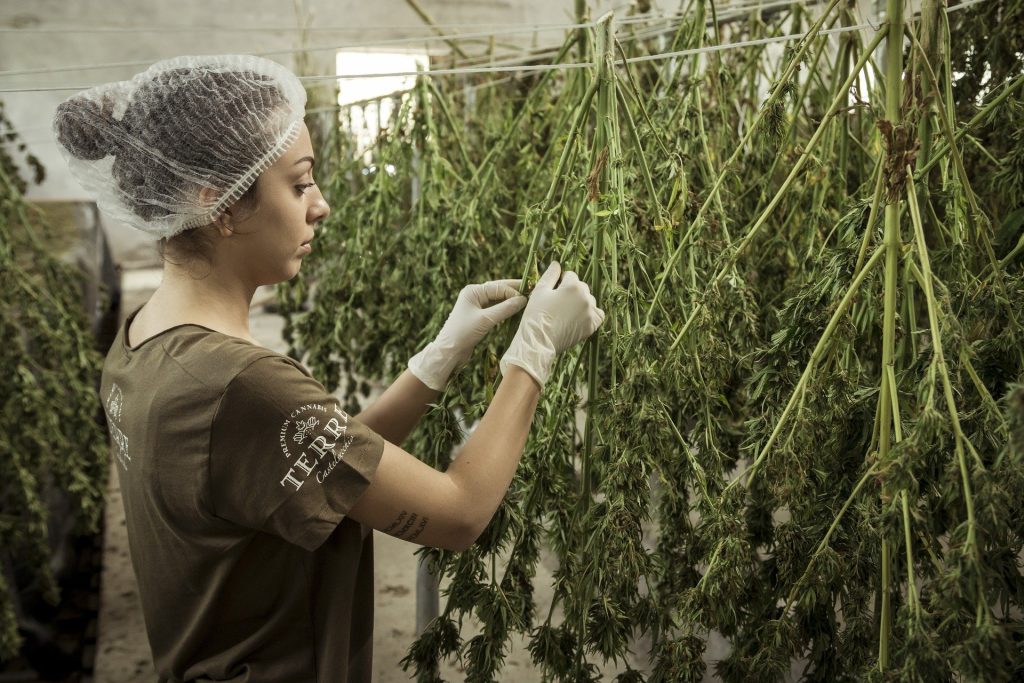Humidifying the storage environment for hemp is important to keeping product weight. Storing plants with specified humidity levels can keep them as close to fresh as possible with all related qualities once they’ve been picked, cured or dried. When it comes to CBD, storage of hemp flower needs to be controlled to retain as many of the plant’s fresh attributes as possible.
Hemp: Storage for CBD Extraction
Hemp storage spaces must be controlled for temperature and humidity ranges. Historically, bundling hemp plant for extraction was done using large bags that kept out light and oxygen–a sufficient solution. Those bags were used when hemp did not have full federal legalization and instead was used for textile and rope. The market quickly changed under the U.S. Farm Bill 2018 which granted full federal legal status. Using hemp for CBD extraction requires a more delicate approach. Stored hemp must be kept in the relative humidity range between 57-63% in order to support the eventual process of extraction. Since hemp can be stored this way for months at a time, humidity can play a key role in maintaining quality.
For cold store of hemp plant and flower, humidity plays a role in keeping product weight. The extreme cold HVAC can tend to quickly remove not only humidity from the immediate space but also leaves the plant prone to lose water weight through evaporation into the storage space. Standard for production is to give the hemp plant and flower time to cure and dry. Further reduction of moisture content in the plant during storage can deteriorate delicate terpene, cannabinoid, flavor and color profiles.
Controlling Humidity For Hemp: It’s Always Relative
There is a reason they called it ‘relative humidity’ and in our line of work and experience, we’re extremely familiar with the dance these two have in an environment. In a lab somewhere far, far away, humidity can be taken as a stand alone attribute of the environment. In real life (IRL!) the two cannot be separated. In the middle of a long summer, you wake up in the morning and ask: what is the humidity level today? It may say 30% which seems reasonable but on a day when temperatures reach 110°, that 30% is unbearable. That humidity level ‘feels’ more extreme because the relative temperature has an impact on how quickly that humidity is able to evaporate into the air.
For a storage facility which keeps the temperature around 78° or less, for example, the addition and control of humidity quickly becomes important. It will typically take refined amounts of humidity to keep levels within current industry standards: between 57% and 63% Rh. And you definitely don’t want a humidity system that will overshoot that range—relative to the temperature. The humidity system you install should utilize controls that always react to any changes or variation in temperatures in the environment. Control systems play a key role in making sure temperature and humidity requirements are delivered with precision.
Storing Hemp For Extraction
Hemp extraction can be done in a few ways. But crucial to any extraction process is keeping the raw product from further drying before it goes to extraction. Whether it’s done by cold CO2 bath, oil or water extraction, the closer the plant is to fresh means that the quality, flavor along with turpene and cannabinoid profile, will persist through to the end of each process. The market for cannabidiol (CBD) products derived from Hemp has become more popular than ever. CBD’s use as an additive forms the 2020 projected $1.2-1.9 billion U.S. consumer market (1,2) across a wide array of food, drink and body products. Modern, sophisticated consumers are more sensitive to packaged CBD-based product qualities of strength, flavor and color.
Hemp: Controlled Humidity Retains Quality
Just like other organic-based food and beverage products, the ‘terroir’ of hemp can influence the end product once CBD is incorporated. And similar to wine, as the market evolves and an appellation system(3) is enacted, local qualities of hemp(4) will play a larger and larger role in that marketplace. Specific qualities of the crop will demand higher prices on the open market. The delicate effect of the flavor, color and intrinsic plant profile will make or break the end product and price per pound for hemp growers.
Using tobacco as a model, keeping stored product in the range of 57-63% Rh seems to be where the market is going. Currently, there are no standards or necessarily best practices at this point regarding cannabis or hemp storage. Growers must maintain as much weight as possible in the plant to maximize profits. Once cured and dried, storage is important for retaining crop profiles for the best end result once extraction methods are utilized.
Do you need an expert team to guide you on humidity systems? Do you need a system custom-built for your facility? Speak with one of our friendly experts today!
phone. 1-800-322-4364 or 1-760-322-1111 | email. fog@microcool.com
Resources used for this blog post:
1. https://www.statista.com/statistics/760498/total-us-cbd-sales/

